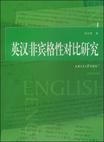英汉非宾格性对比研究
2009-2
上海交通大学出版社
张达球
248
本书在形态和句法层面对英汉两种语言中的非宾格现象进行对比研究。句法上,汉语中存在大量不及物动词带宾语现象,其中有词汇层面的动宾式(或称述宾式)复合动词,这是形态所涉及的范畴;也有短语结构层面的动宾式(或称述宾式)动词短语,这是句法所涉及的范畴。这种动宾式(或称述宾式)复合动词和动词短语的定性是学界长期争论悬而未决的老问题。形态上,本书主张从字本位出发,而不是从传统上的词本位出发,来探讨汉语的非宾格性问题。字本位观与本书所采用的分布形态观相类似。分布形态观对词性不作区分,而是把核心词类当作词根(Root),有名词词根、动词词根、形容词词根等。本书采纳这一体系把汉语的核心字类作为字根处理,如“出汗”、“流血”、“生气”、“闪光”、“出声”等传统上认定的动宾式复合词中都由一个动词性字根和一个名词性字根合并而成。 根据Hale和Keyser的论元结构理论,本书认为许多汉语动宾复合动词经历了一个词汇一句法操作过程。这些动宾复合动词在进入句法结构之前,本质上是非作格性的,但通过词汇一句法层面的合并操作,词汇内部结构以非宾格性形态进入句法推导,其句法语义功能仍保持非作格性。 汉语的典型不及物动词“来”、“死”、“笑”等都具有两类不同的结构表征:其中一类是在动词(如“来”、“死”)后直接带有NP,另一类则可能通过动词(如“笑”)与其次谓词(如“死”)共同(“笑死”)带有一个名词NP。汉语文献中一般都把这些结构看作是不及物动词带宾语现象。但本文认为,这些结构实际上就是不同形态的非宾格性表征:分别表征为存现结构(ECs)和动补结构(RCs)(包括描述性谓语结构)。
本书在生成语法框架内对英汉非宾格性结构表达进行对比研究。在经典范畴之下,现代汉语对动词只进行及物性与不及物性两分,而本书认为汉语应该与英语一样,有必要对动词再作进一步的划分,把其中的不及物动词再分为非宾格性和非作格性两个次类。这样就可以对汉语中大量的不及物动词带宾语现象以及其他不及物动词后带名词现象作出明确的甄别。本书对非宾格性句法配置的研究,不是单纯在词库中对动词的词性进行非宾格性界定,而是在句法配置上对动词的非宾格性进行判别,对其句法结构表征进行生成解释。这不仅深化了汉语动词的及物性范畴,而且也拓宽了对汉语句法结构的研究视野,使汉语研究更好地与西方语言研究接轨。
1 Introduction2 Theoretical Backwood 2.1 Argument Structure(AS) Theory 2.2 Syntactic Approach to Lexicon-Syntax Relations 2.3 Conceptual Primitives at Semantics and Syntax Interface 2.4 Summary of the Theoretical Background3 The Unaccusative Hypothesis 3.1 The Unaccusative Hypothesis 3.2 Approaches to Unaccusativity 3.3 Unaccusative Verbs in Heterogeneity 3.4 Levin and Rappaport Hovav's Linking Rules 3.5 Summary 4 Morphosyntax in Modern Chinese 4.1 Introduction 4.2 Compound Predicates in Chinese 4.3 V-0 Compounding Revisited 4.4 A-0 Compounds Revisited 4.5 Motivation for L-Syntax Theory 4.6 L-Syntax in Compounding in Chinese 4.7 Derivation of Deadjectivals in Chinese 4.8 Summary5 Unaccusativity of Existential Constructions 5.1 Introduction 5.2 Approaches to ECs in English 5.3 Existential Constructions in Chinese 5.4 Constraints on the ECs in Chinese 5.5 EC Compatibility Test with Verb Subclasses 5.6 Configurational Approach to ECs 5.7 Introducing NPmc to ECs in Modern Chinese 5.8 Some Controversies and Solutions 5.9 Summary6 Unaccusativity of RCs in Modern Chinese 6.1 Introduction 6.2 Crosslinguistic Lexical-Syntactic Flexibility 6.3 Syntactic Representations of RCs in Chinese 6.4 Different Approaches to RCs in Chinese 6.5 Syntactic Configurations of RCs in Chinese 6.6 Summary7 Concluding RemarksAppendix Bibliography后记
2 Theoretical Background It is generally agreed that,of the two fundamental lexical categories,verband noun,verb holds the dominant status in the specifications of information,offers complex syntactic and semantic information for a sentence,and alsodetermines the syntactic structures with the semantic restrictions on the Cooccurrence of the nominal components(Fillmore,1968;Chafe,1970).Verbs aregenerally splitted into two subclasses,the transitive and the intransitive,in termsof whether they take an object or not.But things are not SO simply regular.Manytransitives may not necessarily subcategorize an object NP,whereby they aresupposed to have the property of intransitive verbs.On the other hand,manyintransitive verbs sometimes also take an“object”NP。which may be regarded ashaving the property of the transitive verbs.This is a popular case,and it is noexception in Modern Chinese.As a result,it seems to be justified that in ModernChinese no clear boundary is found between transitive and intransitive verbs,justas it is the case with the entanglement of various intransitive verbs which shouldhave been distinguished otherwise as unergative and unaccusative verbs in termsof their syntactic properties as have been done in European languages.But thisreclassification wins no much response from the scholars working on Chinese.Nosystematical research has been done on the unaccusativity of the Chinese languageever since the debut of the Unaccusative Hypothesis by Perlmutter(1978).Juston the basis of such observation,this book mainly deals with the syntax andsemantics of the argument structure configurations of the intransitive verbs,theunaccusative ones in particular,in Modern Chinese.

推荐阅读,不错的书推荐阅读,不错的书籍籍